Editor's note: Don and Shelly Hafner are counting down the days until they set out on an ambitious tour: 59 national parks in 59 weeks! It's an audatious bid, particularly when you consider they'll have to crisscross the globe, from the far Pacific to Alaska, down through the Lower 48, and off to the Caribbean. How will they travel? They put a lot of thought into that question, and for most of their trek they'll be hauling a trailer. If you've ever considered traveling to the parks by RV, you might want to see what the Hafners went through in deciding on their 27-foot-long Surveyor. And you can keep up on their trip by following their blog.
When we first hatched our plan to visit all 59 national parks in sprint-like fashion, we really didn't know how were going to do it logistically. About the only thing we knew for certain was that we wanted to take our Maltese puppies Bubba and Lilly. Everything else was on the table.
We had always stayed at lodges and hotels on previous visits to national parks. We initially thought that would work this time. Not so, too many pet restrictions. We had to make some adjustments. One suggestion was that we not take the dogs. That idea was immediately shot down. We turned our attention to getting an RV.
We had never owned an RV before. In fact, we had never really gone camping before. The CEO of 59nationalparks.com (Shelly) has always declared that her idea of camping was a hotel without room service.
We didn't want to overspend though and started looking at pop-up campers. That idea didn't last too long when we learned that we could not pull it with our Ford C-Max. That and we saw the bathroom configuration on a pop-up. No thanks.
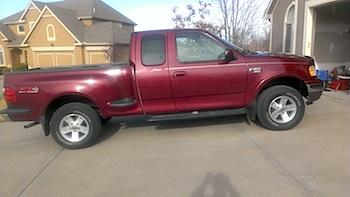
A "new" used truck was just the thing to pull our trailer. Don Hafner photo.
We really didn't want to purchase another vehicle so we started looking at Class C RVs. For the uninitiated, a Class C RV is similar to a van chassis with a large camper attached. Ultimately we decided (with lots of advice from others) that a Class C wouldn't work. We would be constantly hooking up and "unhooking" at RV campgrounds. For us to effectively get the photographs we wanted, that would just take up too much time not to mention the hassle factor. We also drove a Class A motorhome. No way, too much like driving a bus.
We concluded that we would need to purchase a travel trailer. That decision also entailed the requirement that we bought a truck for hauling our RV. Picking up a truck was easy. I know some "guys." We found this 2003 Ford Lariat 4x4 with 73,000 miles and reasonably priced. Too easy.
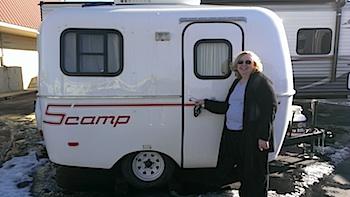
The Scamp was interesting, but not for us. Don Hafner photo.
There really was nothing easy about buying a travel trailer. Too many options, too many requirements and a few scoundrels along the way as well. We knew for our purposes that smaller was better but a Scamp just didn't work for us.
Here were our requirements:
* First, we wanted to limit the weight as much as we could. Recall we had never done this before, so something we could manage was important to us.
* Second, the travel trailer had to be in our budget (mission accomplished).
* Third, the RV could not have any water damage. We saw several travel trailers that did. Water damage spells catastrophe for a travel trailer. Some of the people selling travel trailers tried to hide this damage, so buyer beware. Recall that above I mentioned that we met some scoundrels.
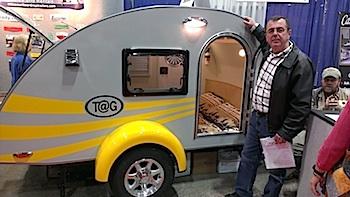
The Tag was cute, but not going to stand the test of 59 parks. Don Hafner photo.
* Fourth, it had to have sufficient storage space to accommodate a year-long plus trip. Not easy when you are trying to keep the weight down.
* Fifth, the RV needed a few features, such as a stove and a queen-size bed. My best guess is that we considered 35 + travel trailers before making a decision.
We finally found an RV that met all of our needs at Camping World of Kansas City. We picked up a 2010 Surveyor on December 31st, 2013. We were satisfied with the travel trailer and with the value we received. Our (third) salesman Dave did an excellent job. The living area/kitchen is in the rear, bathroom is in the center and the bedroom is in the front. It measures 27 feet and has a dry weight of 4,300 pounds. There is no water damage and everything functions as promised.
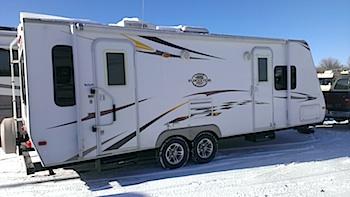
This gently used RV will be home for us for a year on the road. Don Hafner photo.
RV Tips:
1. Buy what you need and be patient finding the right fit. We believe many people will be inclined to over-buy and sales people are ready to accommodate that urge.
2. In our experience, there is no price or quality advantage gained from buying from an individual over buying from a dealer. In fact, a dealer is necessarily going to have more accountability for a lot of reasons.
3. RVs have a significant mark-up, much more than cars do. The one we purchased was priced at $13,800 (the price is still written on the hitch and we are leaving it there). Based on published wholesale values, we concluded that it was marked up about $5,550. High-end RVs are marked up tens of thousands of dollars. While pricing guides for RVs aren't as readily available as they are for cars, they are still accessible on the Internet. Do your research before making a decision.
4. Yes we did hear the sentence, "What Does it Take to Get You Into an RV Today?" more than once. We found that buying an RV was much like buying a car, with many of the same pitfalls. Be prepared for that, have a strategy when you shop. Let them know that you are aware of the wholesale and retail values of RVs. Let them know then that you will be writing a review of your experiences. Communicate your needs and expectations from the beginning.
5. Finalize your deal on the last day of the month. Better yet, if you can, finalize on the last day of the year as we did. Camping World was highly motivated to make a deal on December 31st.
6. Quite unlike a car, an RV requires that you purchase many other accessories for it to be travel ready. RV accessories are commodities, treat them as such. Ask a lot of questions before you spend more money on extras. Have a budget to buy a new mattress whether you are buying new or used. We highly recommend that you invest in a high-quality hitch equalizer. They are expensive, but will really increase the ease of towing your camper.
7. We give the Good Sam Club our full endorsement for quality of services, pricing and friendliness. Check them out if you are in the market for an RV at www.goodsamclub.com. This is not a paid endorsement. We have met several of their ambassadors--good people.
8. Attend an RV show. We recently went to the show in Kansas City. There were all varieties and brands available to browse. Since there were multiple dealers there, we believe the competition for business was intense. Chances are good that the dealers were willing to make deals.
9. If you need RV storage, arrange it in advance. After you finalize your purchase, an RV dealer will want the unit off their lot. There is a strong demand for RV storage, so make sure that you have the right place at the right price available.
10. If you are planning to make a long trip this summer to a national park or other destination, consider making a trial run to a nearby park or campground. This will allow you to "learn the ropes" without the stress of a long drive, demands of instant gratification by your children, and the unanswered questions about set-up. Did you know, for example, that lighting an oven in many RVs requires a match?
We are going to make our trail run to Branson, Missouri, in March before we hit the big time. We are so looking forward to our 59 National Park journey, which begins in just 67 days. Yikes, so much left to do! We are grateful that we have the RV purchase off of our check list. Happy camping!

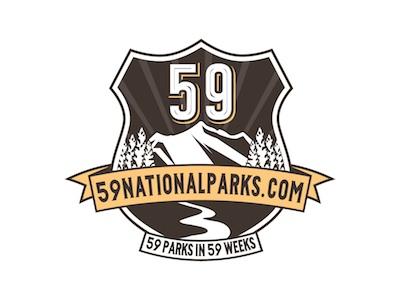


Comments
This is a wonderful article. I am excited for the both of you and wish you much luck with your travels. My parents, when they first retired, owned a 33-foot RV. They were members of the Good Sam Club. Their big plans were to do alot of traveling in that vehicle. Be aware (which you probably are already) that you may have lots of various and sundry repairs that might pop up. At least, that's what Mom & Dad ended up having and this was with a brand new vehicle. And, when they had to opt for a larger RV repair, it was not always easy for them to find a town on the road that could accommodate such an effort [size= 0.95em; line-height: 1.45em](of course, that was over 20-some years ago, too)[/size][size= 0.95em; line-height: 1.45em]. That being said, they really didn't get to use the RV as much as they wanted because it turned out to be a bit much for them (Mom hated driving that big thing). I think Dad, at least, regretted not doing more traveling in it (even though he was the one driving all of the time).[/size]
I have followed the exploits of another photographer on Flickr (Mike Jones) who lives and travels year-round from his RV. He works for a company that sells calendars, cards, etc. He actually installed solar panels on the roof of his RV. He loves that vehicle and has traveled all over the U.S. in it.
I'm envious of the both of you and again, wish you much luck, fun, and great photography during the amazing year I know you will have.
We are doing the same thing, though we leave in three days. First stop: Congaree National Park. Best of luck to you and maybe we will see you on the road.
Dahkota. That is fantastic! Perhaps we will cross paths. We arrive at Hot Springs National Park on April 1st. Let's keep in touch.
As a person who works in the RV business, I would add that some RVs are not made to be full timed in and will not hold up as well in full time use. Also many trailers will not work with water in freezing temperatures so plan your routes carefully. I would also suggest when full timing in an RV you look for a model with more than adequate storage of food, clothes and gear because you will take a full assortment of clothes for different weather conditions, more so than on a weekend or two week vacation. This sometimes means the smallest trailers are just too small for a full timer. Buying from a local dealer you trust is very important. Not just because that is what I do, but because if you have an issue, they are your first help and the dealership should have done a complete prep where all systems have been run and checked. A dealer will not be in business long if people complain about problems that are not addressed. Plus if you forget how something works or need assistance, they will talk to you over the phone while on a trip and can be very helpful with their customers.
Equalizer or other quality weight distributing hitch is not only a good idea but is required when a certain trailer weight or tongue weight is reached depending on the tow vehicle. Also sway control is sometimes built into this hitch or can be added and is very helpful in wind or when being passed by another big vehicle. Both of these safety devises are extremely important.
Some wise counsel from David Crowl. May I add a caution, too?
Beware of motor homes. Through the years I've seen many families whose vacations were damaged or destroyed by mechanical problems with their portable house. It's not much fun to do your camping in a mechanic's parking lot while waiting for parts or repairs.
A trailer has many advantages. When you need to make a fast trip to the grocery store, you don't need to pull up camp. You don't need to tow a vehicle for local transportation. Trying to park a large RV is sometimes nearly impossible.
With a trailer, you set up camp and then go sightseeing or errand-running like a normal person. Twice, my family was stranded when our tow vehicle broke down. But we were able to set up in a campground while it was repaired. The most memorable time was in the Black Hills over the Fourth of July when our transmission went out. The Fourth was a Monday. The transmission died on Friday. The Dodge dealer in Rapid City was wonderful. Helped us set up in a KOA near Mt. Rushmore, loaned a car for our use and then closed down for the weekend. The following Wednesday, we were on the road again.
T'would have been a very different story if we'd been driving a motor home.
I envy your journey. When my parents retired hey had a similar type of mission. They bought a 5th wheeler and planned to see a game in every major league baseball park. Unfortunately, my mother's health took a sudden fail before they launched, and they never made the trip. With both gone now, I do dream of some sort of a similar road trip someday, for them and for me.
My biggest fear of driving anything larger than my current Subaru Forester is fuel costs. I see RVs of all sorts and types pumping gas/diesel and it looks to me like they have to take out a second mortgage just go get filled up. It has to be a serious consideration for all but the most affluent.
Yes Rick, We in the industry often joke that if you ask "what is the fuel economy on a motor home"...than you can't afford it. Actually it is similar to pulling a big trailer... about 8 to 10mpg. Some small units can be better and diesel can out do gas in mpg but the price of the diesel engine costs are big. Diesel engines have much more pulling power for heavy units and often get better mileage than a gas engine pulling a smaller trailer.
Lee what you said is good to consider. Many people driving motor homes choose to pull a car for sight seeing and grocery runs. So the idea of a motor home does not always get you out of pulling something.
I have had many customers who have taken the trek to Alaska and back. Most say plan on replacing tires when you get back. And I have talked to a few that say they will not go again without a second spare tire. One word of wisdom...tires on trailers often age out before they wear out. If you are looking at a used trailer that is about five years or older, make sure it does not have original tires before venturing on a long trip. Tires often look like the tread is good but they have dry rot from sun damage. If a tire has a blowout while driving on the highway they can cause serious damage to the trailer when they come apart.